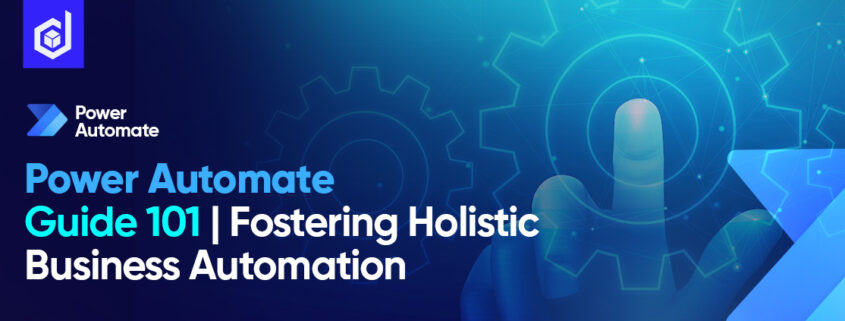In the ever-shifting business world, there is always a scope for improvement. Organizations keep looking at ways that improve performance levels and help gain an edge over the competition. Many businesses across the globe are undergoing operational automation to stay ahead in the run. With comprehensive automation tools, human activities are simplified, and operation costs are reduced.
The Microsoft Power Automate, a core component of Microsoft Power Platform, enables business users to connect apps, streamline processes and improve efficiency. With the inclusion of intelligent workflows to handle complex tasks, businesses can maximize productivity and amplify work performance.
This blog demonstrates the role of Power Automate as it speeds up business processes, reduces manual effort, and empowers individuals to trigger automation. With a comprehensive guide into the essentials of Power Automate, it gives an insight to business users before beginning the business automation journey.
Automate with ease | A low code solution for IT workflows
Power Automate is gaining tremendous recognition for helping users and organizations in leveraging productivity and automation that saves money, scales tasks, and supports desired goals. Organizations deploy fast and easy digital solutions to confidently scale, owing to the strengths of Power Automate. Open for the coders and non-coders to perform the next-generation digital transformation, users can accelerate their businesses with intelligent low-code apps and turn ideas into viable solutions.
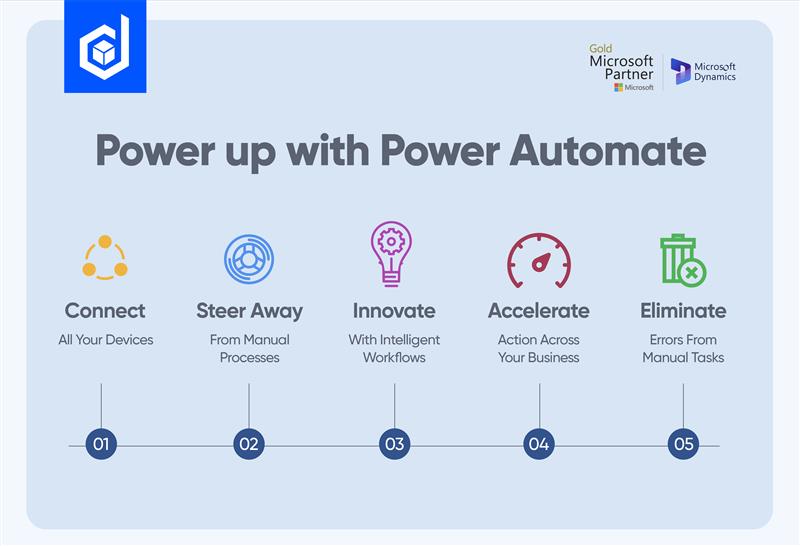
Moreover, Power Automate is one of the pillars of Microsoft Power Platform, which automates workflows with an API-based approach, exchanges data with legacy on-premises software, and integrates AI models into the workflow with a low-code approach.
Here is a compilation of some of the commonly used flows in Power Automate:
- Automated Flow: Create a flow that performs one or more tasks automatically after an event trigger it.
- Scheduled flow: Create a flow that performs one or more tasks on a schedule
- UI flow: Record and automate the playback of manual steps on legacy software with robotic process automation (RPA)
- Business Process Flow: Define a set of steps for people to follow to take them to the desired outcome.
- Button Flow: Run repetitive tasks from any place, at any time, via your mobile device.
Businesses are accelerating and managers are seeking out new ways to be efficient and productive as they drive value and deliver strategic and innovative thinking. Quite often, the ‘busy work hours’ consume the finite business hours. The inclusion of Power Automate lets businesses replay automation whenever needed.
Ultimately, Power Automate is all about automation and simplifying tasks.
Moreover, Power Automate is one of the pillars of Microsoft Power Platform, which automates workflows with an API-based approach, exchanges data with legacy on-premises software, and integrates AI models into the workflow with a low-code approach.
Here is a compilation of some of the commonly used flows in Power Automate:
- Automated Flow: Create a flow that performs one or more tasks automatically after an event trigger it.
- Scheduled flow: Create a flow that performs one or more tasks on a schedule
- UI flow: Record and automate the playback of manual steps on legacy software with robotic process automation (RPA)
- Business Process Flow: Define a set of steps for people to follow to take them to the desired outcome.
- Button Flow: Run repetitive tasks from any place, at any time, via your mobile device.
Automating the Tasks and Leveling up the Value Game
Businesses are accelerating and managers are seeking out new ways to be efficient and productive as they drive value and deliver strategic and innovative thinking. Quite often, the ‘busy work hours’ consume the finite business hours. The inclusion of Power Automate lets businesses replay automation whenever needed.

View Power Automate Post on LinkedIn
There are some quick examples of organizations seeking Power Automate to streamline tasks:
- Adding Business Convenience via E-mails
Power Automate saves the client-centric email attachments in a relevant SharePoint folder. It saves time in searching for the designated email, downloading, and saving it in the correct document library. It sets up a template and sends up a push notification to alert the user, for a timely response. Additionally, it helps the businesses stay industry-relevant with the new D365 opportunities.
- Managing Leave Requests and Approvals
Power Automate effectively manages time off throughout the year for each employee. At the time of leave application, the employees can send an automated message to the manager and get a notification of their response accordingly.
- Requesting Document Approval via Microsoft Teams
Business proceedings involve reviewing and proofreading critical documents before giving the final approval. This can often be a time-consuming task. However, with the inclusion of Microsoft Teams in Power Automate, a request for document approval is made as soon as the document is uploaded on SharePoint. Once approved, the team members receive a notification, thereby saving time.
- Keep A Check on Business Analytics
The summarized analytical data-driven dashboards hold viable information and some that may even require immediate attention. With Power Automate, the sales reps can be alerted to stagnant sales, or sales managers can be reminded about missing leads. Timely managing the loopholes helps business managers tackle the gaps before they can cause any problems.
- Managing Business via social media
Social media managers routinely require the need to collect popular tweets, mentions, and comments. Manually collecting these mentions with a targeted keyword turns out to be a hectic task. With Power Automate, the media handlers will receive push notifications for every, let’s say, 20 retweeted keywords. It also makes it quick and easy to monitor the impact of a brand on social media.
Microsoft Unfolds Business Agility via Power Capabilities
Power Automate has a diverse connector library, that also converges with third-party connectors too. These include but are not limited to Microsoft-only products (SharePoint, D365, Power BI, Outlook) and go on to add popular ones like Mailchimp, Adobe Sign, DocuSign, Twitter, Google Drive, and Trello to holistically expand the possibilities of what you can build and automate within the business.
The power capabilities do not end here. There is more to it!
Hundreds of pre-built Power Automate templates allow business users to create a flow from scratch using any or multiple connectors available in the Power Automate library. This makes it more accessible than ever, with new experiences to help the users build out their cloud and desktop flows at every skill level. Organizations widely implement Application Lifecycle Management (ALM) with Robotic Process Automation (RPA) for added features and usability.
Application Lifecycle Management
Application Lifecycle Management is an end-to-end application management and automation tool that drives efficiency through predictable and repeated software delivery. It facilitates collaboration between software development teams and related departments to test and operate the defined application for a seamless process.

Based on the application management tool, Power Automate chooses from two categories of enhancements: Solution Cloud-flow Improvements and Core ALM Improvements.
Solution Cloud-flow Improvements
Solution cloud flow improvements contain flows, apps, tables, and more to implement application lifecycle management in the Power platform. Once the flow is created, it is moved to the test environment for isolated testing before progressing to the production environment. It is much easier to use solutions with all the artifacts stored in the Dataverse and leverage the flexibility of connection references and environment variables. Moreover, these solution flows are quick and easier to manage and administer, allowing the administrators to conduct an audit, query, and inventory by quarrying the Dataverse.
Core ALM Improvements
Core ALM Improvements are in addition to the Solution Cloud-flow Improvements and add further ease to swiftly adding cloud flows to the solutions. These include:
- Connection reference panels will now show unfulfilled references for the missing connections.
- Solution-aware flows can be reassigned to a new owner, if the original owner switches teams, to ensure business continuity.
- Sending email notifications for key events including flow failures, throttling, edits, and suspension to solution cloud flow
- Using environment variables in numerous flow triggers
- Clear warning before making changes to the customization artifacts and creating an unmanaged layer
- Push environment variable asynchronously updates into the referencing flows
In all, Application Lifecycle Management combines with people and processes to enable teams to continually provide value to customers and add efficient upgrades for promising efficiency.
Robotic Process Automation
Robotic Process Automation uses intelligent automation technologies to perform repetitive office tasks of business. Combining user interface (UI) interactions and APIs (application programming interfaces) allows businesses to integrate and perform repetitive tasks between enterprise and productivity applications. Deploying scripts initiates the autonomous execution of activities and transactions across unrelated software systems.
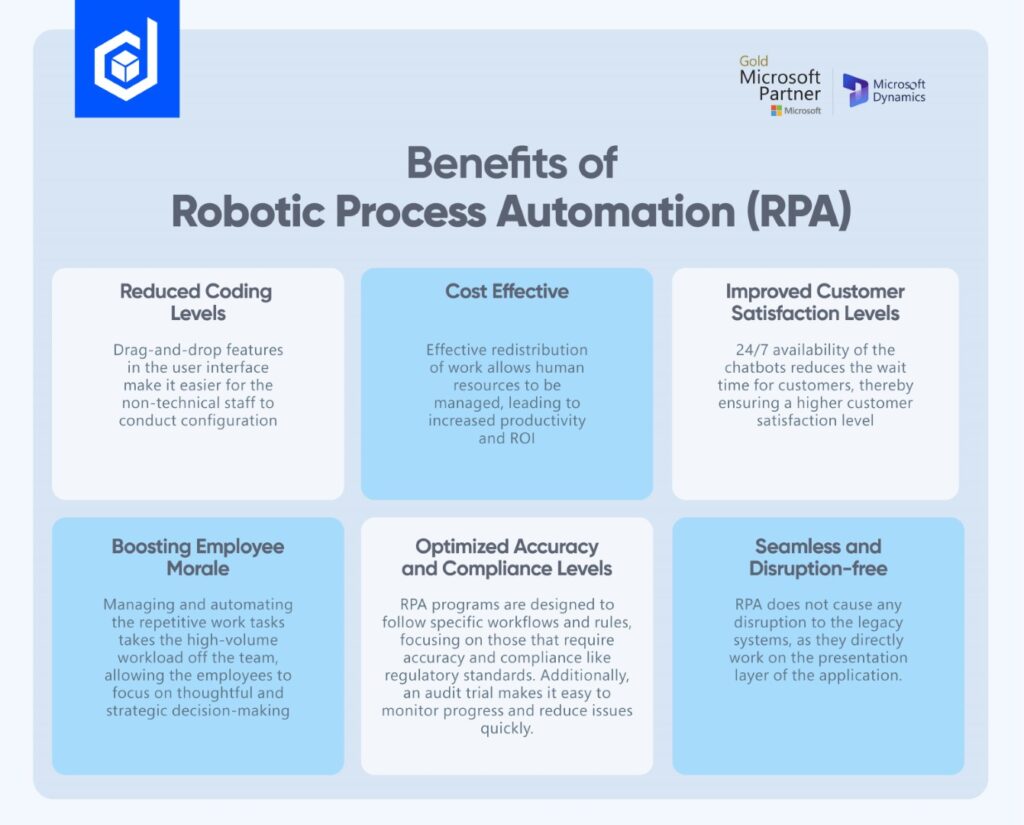
Nevertheless, RPA is dependent on high-quality data and strong data governance. Organizations should develop their readiness to adopt data management processes and data architecture.
Save, Scale & Support with Power Automate
Moreover, Microsoft continues to develop upgrades and added functionalities for optimizing user experiences. Every single feature is focused on bringing a completely new set of experiences to help users build their skill level on cloud and desktop flows.
Follow the link to know more about the newest upgrades in Power Automate 2022 Release Wave 2:
Overview of Power Automate 2022 release wave 2 | Microsoft Learn
How has the market changed since the advent of RPA?
Understanding the Robotic Process Automation (RPA) demand in the commercial market represents many successful business tasks being completed in a timely manner. RPA’s initial processing was adopted by the financial organization, followed by a range of sectors including retail, manufacturers, healthcare, and more.
Along with the ability to process a major chunk of information and process the operations, analytics reflect the surging popularity of the RPA market.
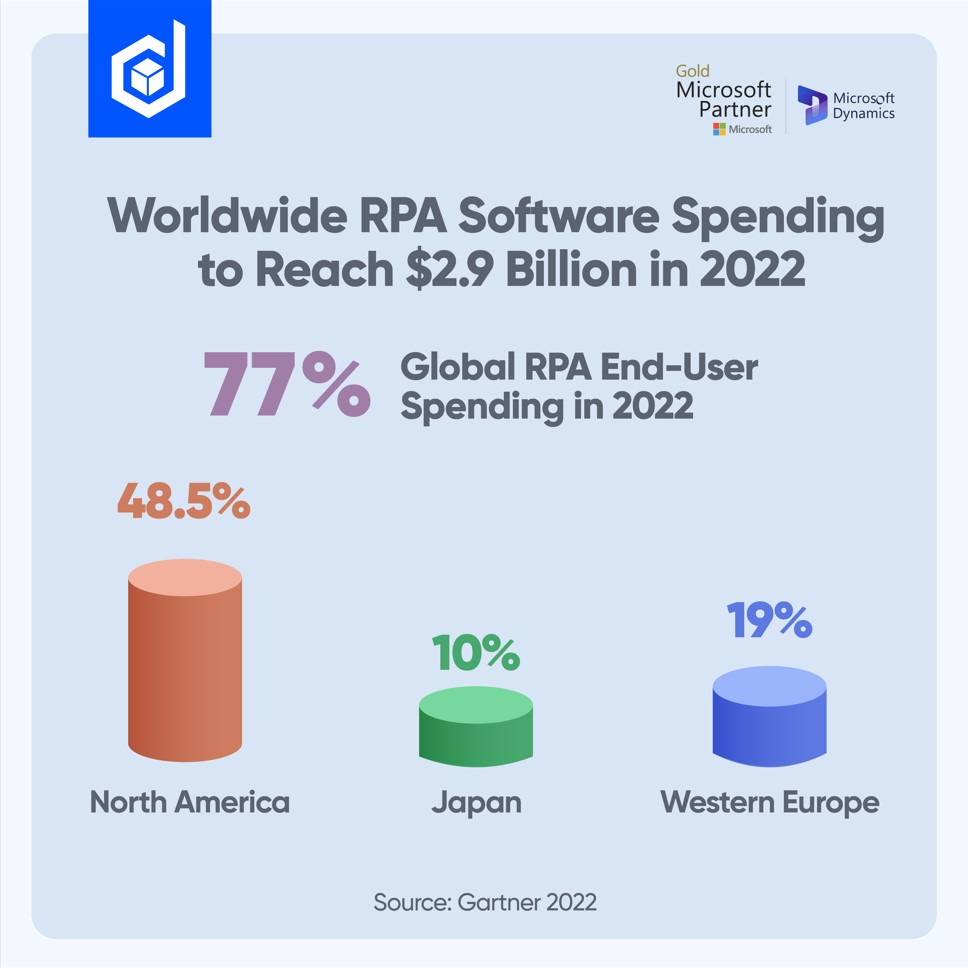
Additionally, it is further expected according to the latest forecast from Gartner, Inc. that the RPA market will experience double-digit growth in 2023, helping businesses in Gulf and MENA region with embedded hyper-automation capabilities.
Four Pillars of Power Automate Functionality
Power Automate’s deep and broad capabilities span four functional capabilities. It is an end-to-end process automation software with a full range of process automation needs and demands. Being AI-supported, the users simply must upload sample data to the relevant model to train it, and then control how the model behaves using point-and-click/drag-and-drop tools. A swift platform to create, scale and execute automated workflows, it spans across the on-premises and cloud-based businesses easily.
Here is a look at how each of these functionalities works:
- Automation at Scale
Power Automate helps businesses scale workflow processes in number, complexity, and scope. These processes are diverse and encapsulate on-premises software and cloud service to tap storage and processing infrastructure to support and deliver projects. These are further converged with other applications for enhanced productivity and collaboration. This provides a comprehensive organization-wide view of the processes and allows room to improve and execute new strategies.
- Seamless and Secure Integration
Power Automate comes with inherent data loss prevention policies, already established from a user-centric view. Built within RPA processes, it ensures that the automated workflows do not expose sensitive information or grant unwanted access to restricted digital infrastructure and data. As a result, employees can only access the data, applications, and services that have already been approved. Once created, process automation runs securely across multiple platforms, and a single management pane controls and views it.
- Accelerated Productivity
Power Automate includes easy-to-use process-creation tools along with thousands of pre-built templates. Individual employees do not have to depend on the IT expert who does not automate the onerous and inefficient manual processes. The user-driven automation process allows businesses to devote their time to value-added operations. It further reduces cost, streamlines the process, and adds productivity.
- Intelligent Automation
Power Automate democratizes automation as well as the AI functionality within automated processes. With AI Builder, organizations don’t have to hire data scientists or machine learning experts to produce intelligent automation. It provides faster turnaround and consistent delivery, improving the quality of products and services which leads to a better customer experience. It is accelerating the digital business transformation goals and improving business outcomes.
Dusting the Obstacles Away
There is no denying the fact that Power Automate’s revolutionary capabilities can strengthen your business processes and enhance efficiency levels. Nevertheless, the transitioning process may become a challenge for some.
Manually switching to Power Automate has traditionally been termed an expensive and labor-intensive transition. Lack of portability and compliance with the universal RPA design standards reflect the need to adopt a bottom-up approach and build the entire digital workforce. Even with the flexible features of Microsoft, RPA bots need to be switched altogether to get them converted, from one platform to another, and match functionality. These complexities include:
- Lack of code parity – There’s a significant catalog of commands, actions, and parameters that are unsupported between RPA tools, rendering bots incompatible from one platform to the other.
- Lost credentials – System credentials associated with the bot aren’t passed on when switching vendors, creating a heavy user management effort to remedy upon migration.
- Absent versioning – Historical versions of bots can be lost when migrating, affecting compliance and impact analysis activities in the target RPA tool.
- Missing audit logs – Audit logs aren’t stored the same way between different RPA tools and may be lost altogether when migrations are attempted.
- Unavailable output compare – There is no effective and straightforward way to run output compares of bots migrating between different RPA tools. This makes it exceedingly difficult to test the completeness and quality of bots after the migration, ensuring they still do what they were designed to.
The expense and investment alone for migration usually make it a non-starter. However, there is a way to migrate entire digital workforces faster and at a fraction of the cost, it normally demands.
Eliciting User-centric Powerful Relationship
Since its advent in 2016, Power Automate has grown to become one of the most important automation services available to enterprises. The user community has steadily grown to thousands of members, thereby helping Power Automate grow into a service and enabling billions of process automation every month.
The initial 35 connectors have multiplied to become 300+ connectors that fulfill the goal of providing customers with a robust automation service across the IT landscape.
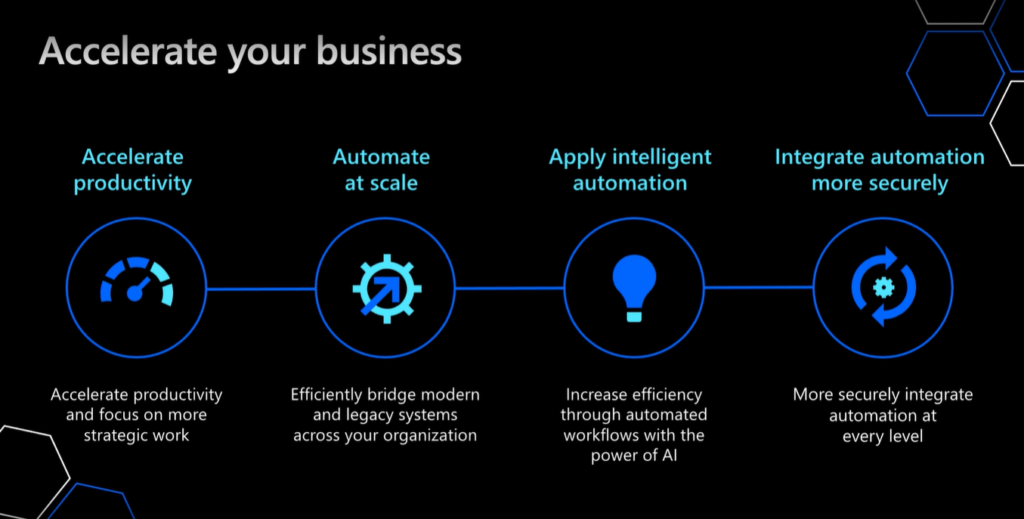
Video Link: Accelerate Your Business with Power Automate
In all, the process of business automation has rapidly increased in recent years as SMEs continue to look for efficient ways to streamline complex tasks. Built within Microsoft Dynamics 365, Power Automate’s low-code solution provides an easy interface for users to set up intricate automated tasks.
Nevertheless, it is equally important for organizations to look for the right solution implementation partners for seamless execution. Failure to do so results in many automation problems along with insufficient returns, unsatisfactory promises, and frustrated customers.
Therefore, it is always important to search for an adequate solution partner that can promise scalable, and time-saving workflow automation in a single platform and increase efficiency. Coupled with knowledge and resources, their expertise will allow for agile and swift digital business automation without any data loss.
And more…
That’s precisely what we cover in the last part of this blog- why do organizations need certified experts to switch easily to Microsoft Power Automate, faster and cheaper while overcoming all the obstacles listed above?
Dynamics Solution and Technology | Accelerating Business Automation
Business automation, with successful implementation, becomes a powerful tool steering your business toward success. Further, it enables businesses to enhance simple or complex processes across the entire organization with intelligent, low-code apps and with a small learning curve. We at Dynamics Solution and Technology can help you define a scope & assign a team of skilled resources to build & implement automated workflows and accelerate your business outcomes!
With a diverse set of expertise in handling the execution and customization of Microsoft Dynamics 365, we craft automation strategies for your business that promise efficiency and productivity. Our D365-certified team consists of dedicated experts who can expertly handle organization-wide automation tasks and unify them singularly. From connecting the bots to all the relevant dependencies, systems, and constraints, facilitating better RPA change management and risk analysis maximizes RPA uptime for higher returns. This synchronization expedites the migration of your entire digital workforce at 80% of the cost and 3x faster.
Are you considering switching but don’t know what it would cost or how to do it? We can help.
Don’t hesitate; there’s nothing to lose and everything to gain.

